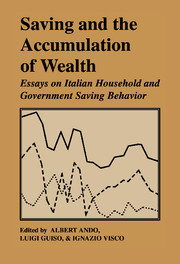Book contents
- Frontmatter
- Contents
- Foreword by Antonio Fazio
- List of contributors
- List of figures
- List of tables
- Acknowledgments
- Introduction
- I Saving trends, government deficit and demographic changes
- II Life-cycle saving and precautionary motives
- III Borrowing constraints, intergenerational transfers and bequests
- 9 Saving and borrowing constraints
- 10 Durables and non–durables consumption: evidence from Italian household data
- 11 Intergenerational transfers and capital market imperfections. Evidence from a cross–section of Italian households
- 12 Bequests and saving for retirement. What impels the accumulation of wealth?
- Appendixes
- Index
10 - Durables and non–durables consumption: evidence from Italian household data
Published online by Cambridge University Press: 05 May 2010
- Frontmatter
- Contents
- Foreword by Antonio Fazio
- List of contributors
- List of figures
- List of tables
- Acknowledgments
- Introduction
- I Saving trends, government deficit and demographic changes
- II Life-cycle saving and precautionary motives
- III Borrowing constraints, intergenerational transfers and bequests
- 9 Saving and borrowing constraints
- 10 Durables and non–durables consumption: evidence from Italian household data
- 11 Intergenerational transfers and capital market imperfections. Evidence from a cross–section of Italian households
- 12 Bequests and saving for retirement. What impels the accumulation of wealth?
- Appendixes
- Index
Summary
Introduction
Much empirical analysis of consumption and saving decisions abstracts from the existence of durable goods. Yet consumer durables represent an important part of the personal sector, wealth and decisions to purchase and sell durables have a major impact on overall consumer expenditure (and contribute to its marked pro–cyclical nature).
One reason for the relative neglect of consumer durables may be that satisfactory data are hard to come by. Aggregate purchase data are normally available but no information is usually provided that allows to distinguish between changes in the number of consumers who own and changes in the average stock owned. Also, no direct information is available on the value of the stock. Hence, few studies have taken the representative agent paradigm down the path of modeling consumption in durable goods (one exception is Dunn and Singleton, 1986). Furthermore, household–level data do not normally contain information on durables, beyond ownership and (at best) net purchases. This severely limits the scope for microeconometric research.
The ideal data set for the econometric analysis of durable goods consumption is a long panel, with high–quality information on all types of expenditure and retrospective questions concerning durable purchases and sales. Such a data set does not exist, and indeed is unlikely ever to exist: detailed questions on expenditure normally involve filling in diaries, and this is time–consuming. The ideal data set would likely suffer from serious attrition problems.
- Type
- Chapter
- Information
- Saving and the Accumulation of WealthEssays on Italian Household and Government Saving Behavior, pp. 305 - 329Publisher: Cambridge University PressPrint publication year: 1994
- 4
- Cited by



